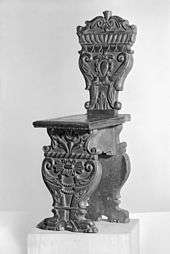Sgabello

A sgabello is an Italian term for a specific type of backstool, moveable seat furniture typical of the Italian Renaissance, when a chair (sedia) usually signified an armchair, a seat of some hieratic importance. Sgabelli are generally made out of walnut and consist of a thin plank or panelled back and an octagonal seat, supported on shaped plank supports, strengthened by a stretcher, which may be turned. This seat would often be placed in hallways, and was often carved with a family's imprese or emblem drawn from its coat-of-arms. Its primary purpose was not lounging comfort.

Similar chairs were made in France. It is also known as the side chair. It has solid supports, which are called rhombus seat supports. It wasn't used for a stool.
A sgabello is an Italian Renaissance furniture object found in the sixteenth century. It is a side chair, made of walnut, with a variety of carvings and turned elements. A sgabello is armless, with a thin back and an octagonal seat, not so comfortable, not designed for long term seating. The legs can be either two decorated boards with a stretcher for support, or three separate impost legs that would be also ornamented and carved.